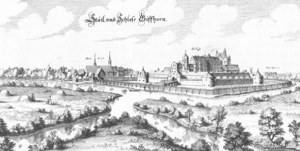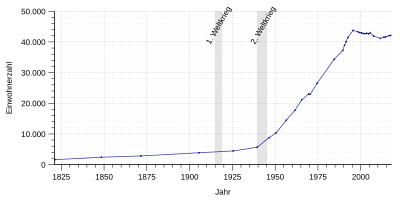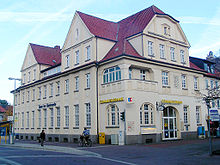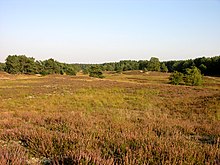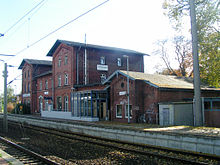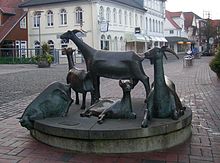Gifhorn
| coat of arms | Germany map | |
|---|---|---|
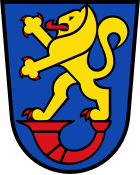
|
Coordinates: 52 ° 29 ' N , 10 ° 33' E |
|
| Basic data | ||
| State : | Lower Saxony | |
| County : | Gifhorn | |
| Height : | 53 m above sea level NHN | |
| Area : | 104.87 km 2 | |
| Residents: | 42,837 (Dec. 31, 2019) | |
| Population density : | 408 inhabitants per km 2 | |
| Postal code : | 38518 | |
| Area code : | 05371 | |
| License plate : | GF | |
| Community key : | 03 1 51 009 | |
| LOCODE : | DE GIF | |
| City structure: | 6 districts | |
City administration address : |
Marktplatz 1 38518 Gifhorn |
|
| Website : | ||
| Mayor : | Matthias Nerlich ( CDU ) | |
| Location of the city of Gifhorn in the Gifhorn district | ||
Gifhorn is the county seat of the eponymous district in the east of Lower Saxony and a separate parish . With around 42,000 inhabitants, Gifhorn is one of the country's medium-sized centers , characterized by the short distance to the industrial and commercial centers of Braunschweig and Wolfsburg . Gifhorn is also part of the Hanover-Braunschweig-Göttingen-Wolfsburg metropolitan region .
geography
Geographical location
The city is located between Hanover , Braunschweig and Wolfsburg, around 20 kilometers north of Braunschweig and the Braunschweig-Nord motorway junction ( A 2 / A 391 ) and around 15 kilometers west of Wolfsburg. The city is located at the intersection of federal highways 4 (north-south direction) and 188 (east-west direction). The Braunschweig – Uelzen and Hanover – Wolfsburg railway lines also cross here on the edge of the Lüneburg Heath . In the urban area the Ise flows into the Aller .
geology
In Gifhorn there is a ridge to the north of the Aller and west of the Ise that was created as an Ice Age moraine ( bottom / end moraine of the Drenthe stage of the Saale glaciation ). This applies to the vineyard and then the Hohe Feld to the village of Wilsche . The Laubberg , the Katzenberg and other prominent elevations south of the Aller, on the other hand, are dunes that were only blown up at the end of the last Ice Age ( Vistula Glaciation ) or at the beginning of the Holocene . In the Aller Glacial Valley, fluviatile periods of the Vistula period, i.e. river deposits, predominate, often covered by drifting sand. In August 2014, a boulder was discovered on a construction site in the city , which had been set up on the banks of the Ise.
Neighboring communities
The following communities border the city of Gifhorn. They are named clockwise, starting in the north (all in the Gifhorn district): Wagenhoff , Wesendorf , Wahrenholz , Sassenburg , Calberlah , Isenbüttel , Ribbesbüttel , Leiferde , Müden (Aller) and Ummern .
City structure
The city of Gifhorn is a unified municipality and consists of the core city with its historic old town and the villages of Gamsen , Kästorf , Neubokel , Wilsche and Winkel . These former communities that were incorporated into Gifhorn all go back to the original villages, which still shapes their appearance today. Wilsche and Neubokel are still clearly separated from the rest of the city today by forests and meadows.
Naming
Between the moraines that formed around Gifhorn in the Saale Ice Age, the large moorland area stretching to the north and the difficult-to-pass Aller glacial valley, the confluence of the Aller and Ise was one of the few suitable dry spots for a settlement and for a river crossing. The name could therefore be derived from word interpretations from traditional documents and place names (especially in the northern part of Lower Saxony) from Giffel, Gaffel, Gabel and Horn (synonymous with "elevation that protrudes into the water"). This is how the Duden Geographical Names in Germany interprets it : “The name 1429 Ghifhorn , 1265 Gifhorn , 1213 [tom] Gefhorne is originally a place designation that characterizes the spur of the settlement in the angle between Aller and Ise (to mnd. Horn in the meaning "Pointed, wedge-shaped piece of land"). The first link Gef-, Gif- is unexplained. ”According to Grimm's German dictionary, the word part Gif could come from a fork (Gaffel, Giffel) of the Ise just before the confluence with the Aller, the presumed settlement core.
history
middle Ages
Gifhorn was mentioned for the first time in 1196 in the inventory of the Braunschweiger Stift St. Cyriakus . The fact that the settlement is much older is proven by the annual ring dating at least to the year 896 of a well that was found on a construction site in November 2014 and secured with wooden planks. Originally Gifhorn was limited to a small settlement in the large, swampy and difficult-to-pass Aller- Urstromtal ( Barnbruch ). The confluence of the Aller and Ise was one of the few places where this natural obstacle could be overcome. Shortly before the confluence with the Aller , the Ise divided and formed a small Werder . The first settlement is believed to be along this dry elevation.
The expansion of the bridge location was favored by several factors. On the one hand it had a geographically favorable protective position, on the other hand it had a good traffic situation at the intersection of two important medieval trade routes: Here the southern extension of the Old Salt Road from Lüneburg to Braunschweig crossed in a north-south direction and the Kornstrasse from east to west Magdeburg to Celle . Gifhorn was fortified with a protective castle against the Sorbian tribes pushing in from the east ( see also Wenden , Wendland ) in order to secure the high-income customs post at the Ise crossing .
The Guelph Dukes later had a bailiwick , a watermill (first mentioned in a document in 1213, a city villa with condominiums is currently being built at this point) and a farmyard. This secure and economically significant hub attracted many farmers , craftsmen and merchants . The post office with its stagecoaches also set up a stop here for fellow travelers (today the Deutsches Haus). In addition, numerous restaurants and stables were built in which the carters unhitched their horses, but also held out for several days in the event of occasional floods . The market rights were granted to the place in 1275 by Duke Johann I of Lüneburg .
Due to its strategically important location, Gifhorn was fortified and mentioned in a document in 1332 as an "opidum" (fortified place). In 1364 it was mentioned that Gifhorn had received the soft image rights ("wicbelde"). This was roughly equivalent to granting city rights . However, the Gifhorns were not allowed to build a city wall. In 1428, when the Welfenhaus was divided, the castle and settlement were transferred to the Principality of Lüneburg .
During the Hanseatic period , many handicraft businesses emerged: The already resident arablemen , millers , bakers , fishermen , butchers , shoemakers , tailors and blacksmiths were supplemented by weavers , bleachers , dyers , cooperators , potters , tanners , saddlers , rope makers , hat makers and beer brewers . The economic heyday culminated in 1275 with the granting of market rights.
Renaissance
Devastating wars and major fires repeatedly caused severe damage to the place, especially the Hildesheim collegiate feud from 1519 to 1523, during which the places in the vicinity were almost completely destroyed. The reconstruction was crowned with the rebuilding of Gifhorn Castle in the Weser Renaissance style . The builders of the palace, which was only completed in 1581, were the Protestant dukes Ernst the Confessors of Braunschweig-Lüneburg and his brother, Duke Franz from Celle. The result was an extremely well-fortified palace complex, which had bastions at the four corners and was surrounded by ramparts. The chapel in Gifhorn Castle, consecrated in 1547, is the oldest Protestant sacred building in Northern Germany. Today it houses the painting The Incredible Thomas by Johannes Grützke . As a private residence for the highest castle official Caspar von Leipzig, the Kavaliershaus was built in 1546 in the city , built in Renaissance style with a magnificent stone facade.
From 1539 to 1549, Gifhorn was the residence town of the Duchy of Gifhorn under Duke Franz , which he received as compensation for his renunciation of government in the Principality of Lüneburg. On December 6, 1544, the Duke issued a “Reformatio and Order” for Gifhorn, which laid the foundation for the election of mayors and city administration for centuries. Since Duke Franz died in 1549 without male heirs, the Duchy fell back to the Principality of Lüneburg in Celle after only ten years . From then on, the castle served as a hunting residence for princes and dukes from the area or as an apartment for a bailiff. The fortifications of the castle were removed from 1781, because they no longer met the defense requirements of that time.
Numerous half-timbered houses from the time of the rebuilding have been preserved to this day. Notable buildings are the old town hall from 1562 (today Ratsweinkeller with library ) and the Höfer house from 1570.
Modern times

During the Thirty Years and Seven Years' War and the Napoleonic campaigns, the old trade routes became military roads. During the troop marches, there was repeated extensive damage and looting. There were also two large wildfires in 1669 in the south and 1725 in the north. After three more fires in 1872, 1876 and 1891 the townscape was loosened up. Because of the limited space, many burned-down houses were not rebuilt in the same place.
The St. Nicolai Church was built from 1734 to 1744 . Planning and construction management were in the hands of the builder Gerhard Justus Arenhold . The baroque building is in the immediate vicinity of the Kavaliershaus and the old town hall .
After the castle's fortifications were razed around 1780, the surrounding protective walls also lost their importance. This led to the gradual expansion of the city area, especially from 1845 after the two city gates were removed.
Industrial age

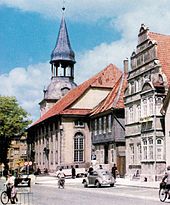
The industrialization of Gifhorn began with the large-scale extraction of peat from the surrounding moor areas, such as the Great Moor . The raw material was processed in the peat press factory and initially provided the energy for a mechanical wool spinning mill, two chicory factories and a brick factory , which did not last long.
Only the Gifhorn glassworks (from 1873) and a canning factory (from 1890), which did not cease production until 1960 and 1973 respectively, became economically significant . They benefited from the completion of the railway construction around 1890.
In 1852 Gifhorn received city rights . In 1924 the town hall was moved to the center of the village. In 1941, 122 people died in the Gifhorn railway accident at what was then Isenbüttel-Gifhorn station.
After the Second World War , there was a large immigration of refugees and displaced persons from the former eastern regions and the Soviet occupation zone across the nearby border . The largest employers at that time were the local machine and fittings factory Alfred Teves (now part of Continental AG ) and the Volkswagen plant in Wolfsburg, which is close by for commuters . In addition, it was possible to locate further companies in new industrial parks. As early as 1959, some squadrons of the Federal Border Police (BGS) moved to the edge of the zone , and the BGS settlement was built on the northwestern edge of the city center. Since the 1960s, workers from southern European countries have moved with their families to the Wolfsburg region and thus also to Gifhorn. This resulted in nationally separate settlement focal points: while Wolfsburg was dominated by Italians, the Greeks were by far the strongest foreign population group in Gifhorn. Even today there is an unusually strong Greek community in the Gifhorn area - now in the third generation - with its own cultural and church activities.
Gifhorn kept the seat of the district of the same name in 1974, after initially a dissolution of this district and merger with the district of Peine and relocation of the district seat to Peine had been planned, but the residents of both districts had successfully resisted. In the course of the regional reform, Gifhorn was reclassified from the Lüneburg administrative region to the Braunschweig administrative region . The industry successfully defended itself against a similar reorganization in court, so that Gifhorn today is not part of the Braunschweig Chamber of Commerce, but still belongs to the Lüneburg-Wolfsburg Chamber of Commerce and Industry .
On November 29, 1984, the new town hall building was inaugurated on the market square. The previous building became the House of Crafts .
After German reunification and the political upheavals in the former Eastern Bloc states , many Russian- Germans moved to the city from the former Soviet Union in the 1990s . They currently make up about a tenth of the Gifhorn population.
Incorporations
With the law on the reorganization of the municipalities in the Gifhorn area of November 27, 1973, the municipalities of Gamsen , Kästorf , Neubokel , Wilsche and Winkel and parts of the municipalities of Isenbüttel, Leiferde, Ribbesbüttel and Vollbüttel were incorporated on March 1, 1974 . As a result, the population grew by around 4,000 and the area of the city tripled.
Population development
|
|
politics

advice
The council of the city of Gifhorn consisted of 34 councilors until 2016, since then 40. The specified number for a city with a population between 40,001 and 50,000 inhabitants is normally 40 council members. By resolution of the city council, this number was reduced by six council members. The council members are elected for a five-year term by local elections. The upcoming term of office began on November 1, 2016 and ends on October 31, 2021.
The full-time mayor Matthias Nerlich (CDU) is also entitled to vote in the council.
The last local election on September 11, 2016 resulted in the following:
- CDU : 15 seats
- SPD : 10 seats
- Alliance 90 / The Greens : 5 seats
- AfD : 4 seats (only 3 seats occupied, as only 3 people ran)
- ULG : 3 seats
- FDP : 2 seats
- The left : 1 seat
In April 2020 a member of the SPD and the left-wing MPs formed a parliamentary group of the ÖDP .
mayor
The full-time mayor of the city of Gifhorn is Matthias Nerlich (CDU). In the last mayoral election on September 11, 2011, he was elected with 50.1% of the vote. The turnout was 50.1%. Nerlich took office on November 1, 2011.
- Previous mayor
- around 1564: Ludicke Albers
- around 1566: Marten Koch
- around 1580: Matthias Otten
- around 1588: second mayor Steffen Suerborg
- around 1595: Hermann Holland
- 1614–1634: Heinrich Evers
- 1643–1658: Franz Hardeßen
- 1658–1659: Johann Kogel
- 1659–1665: Hermann Bohlen
- 1665–1695: Christian Koch
- 1695–1708: Wilhelm Meyer
- 1708–1725: Johann Christian Koch
- 1725–1729: Balthasar Rühling
- 1729–1739: Heinrich Otto Schulze
- 1739–1765: Johann Caspar Beck
- 1765–1788: Johann Christian Lüttge
- 1789–1794: Heinrich Jakob Assau
- 1795–1805: Heinrich Wilhelm Jelpke
- 1805–1816: Johann Jakob Mohrmann
- 1816–1830: Carl Friedrich Herbst
- 1830–1849: Johann Wilhelm Hammer
- 1849–1852: Official Assessor Gustav von Quistorp
- 1852-1854: E. Hantelmann
- 1854–1864: Oscar Gülich
- 1864–1874: Burghardt von Bülow
- 1874–1879: Falcke
- 1879–1882: Raschick
- 1883–1885: Thieler
- 1885–1913: Ewald Müller
- October 1, 1913–1. October 1915: Richard Bodemann (fallen)
- July 1, 1916-30. April 1925: Georg Rudolf Grosse
- April 22, 1925-15. October 1925: (acting) Government trainee Lümkemann
- October 15, 1925–4. November 1946: Ludwig Kratz
- September 23, 1946-16. December 1948: Gustav Schwannecke
- December 16, 1948-17. December 1951: Henry Scharpenberg
- December 17, 1951–1. December 1952: Arnold Scheuring
- December 1, 1952–26. November 1956: Otto Armbrecht
- November 26, 1956-18. April 1961: Wilhelm Thomas, SPD
- April 18, 1961–1986: Herbert Trautmann, CDU
- 1986–1988: Helmut Kuhlmann , CDU
- 1988–2011: Manfred Birth , CDU (started the first direct election in 2004 as a single applicant)
- since 2011: Matthias Nerlich , CDU
coat of arms
The city's coat of arms shows a red armored golden lion on a blue background, standing on a red horn with the mouthpiece pointing forward and looking backwards.
flag
The city's flag shows the colors blue and red in two longitudinal stripes of equal width from left to right and the city's coat of arms in the middle.
Town twinning
- Xanthi in Greece
- Korsun-Shevchenkivskyj in Ukraine
- Dumfries in the United Kingdom ( Scotland )
- Gardelegen in Germany
- Hallsberg (municipality) in Sweden
Culture and sights
Buildings and museums

- Evangelical St. Nicolai Church : The hall church , equipped with a circumferential gallery , to which a massive west tower with a baroque hood is in front, was built from 1734 to 1744 according to plans by the agricultural master Otto Heinrich von Bonn . It consists of plastered brick . The interior is dominated by the pulpit altar marked in 1744 . The 1748 by Christian father from Hannover created organ is decorated with a rococo - Brochure from the second half of the 18th century.
- Old Town Hall , Cardenap 1. The half-timbered building with rich carvings, dated 1562, was heavily modified in the 18th and 19th centuries. In the years 1985 to 1988 the framework was dismantled and then rebuilt - reconstructing the presumed original condition. Today the “Ratsweinkeller” restaurant is located in the building.
- The Gifhorn Castle is the most important building Gifhorn. It is built in the Weser Renaissance style and has a castle chapel that is still in use today. Here is also the burial place of Duke Franz von Gifhorn. The castle is home to the Gifhorn Castle Historical Museum with the departments of hunters and farmers, nobility and rural people, craftsmen and merchants, animals and landscape. The castle chapel can also be visited during opening hours. Festivals and markets take place annually in the castle courtyard and in the castle park on the castle lake.
- Kavaliershaus , Steinweg 3. The 1546 Duke Francis (1539-1549) built Kavaliershaus as a timber-framed building with stone front is considered next to the castle as the most important secular building in the town. The builder was Michael Clare , who also worked on the neighboring castle. Therefore, the lavish display facade with a two-storey hall and semicircular attachments has similar decorative shapes. The client was the castle commander Caspar von Leipzig, who had the building erected as a residential building for himself and his family. Today it belongs to the Kavalierhaus community foundation . On the ground floor there is an exhibition room as well as rooms for the Gifhorn cultural association and a magazine editorial office. The "Museum EMMA - Museum Apartment in the Kavalierhaus Gifhorn" is located on the first floor. The last private owner of the house, Emma Wrede, lived in the rooms on the 1st floor from 1930 to 1992. After her death in 1997, her apartment was declared a museum, in which visitors can travel back in time through German living culture from around 1900 to 1965 can undertake.
- Residential buildings . Despite numerous fires (1519, 1669, 1725, 1876, 1891) and after the renovation measures of the 20th century, the city center still consists of a large number of half-timbered buildings from the 16th to 18th centuries. Particularly noteworthy is the Höfersche Haus, Steinweg 2 , built in 1570 , whose beams are carved with rosette motifs. The ground floor was heavily modified for a shop fitting. The so-called Lange Jammer at Steinweg 1 was said to have been built around 1540. The upper floor of the elongated half-timbered building with a hipped roof is partially slated. The building and planning office is located there today. The core of Steinweg 22 dates back to around 1600. During the renovation carried out in 2002/03, the gable that was changed during the Baroque period was reconstructed in the presumed form from 1600, and the old roof structure was replaced by a new one. Overall, the building has been so heavily renewed that - with the exception of a few beams - hardly any historical building fabric has been preserved. The gabled house Steinweg 20 next door was built in 1678. It is completely clad in wood and has a loft . Since the second half of the 19th century, massive residential buildings were also increasingly being built in Gifhorn. These include the arched eaves houses Steinweg 27 (1871) and No. 47 .
- In the internationally known (open-air) mill museum there are numerous mills of the most varied types, also from European and non-European countries. They have been moved here and restored or reproduced true to the original.
- Kulturinstitut Die Brücke , currently only a cultural venue for exhibitions. There is also a small café that is open on the weekends. The institute is located in a monumental building complex in the style of a monastery in an old Russian architectural style next to the mill museum.
- The town hall with 2500 square meters of main usable area was put into operation in January 2006. Theater and music performances take place here. The theater hall with increasing rank is designed for a maximum of 567 people. The technically fully equipped large stage has an area of around 420 square meters (main stage 220 square meters, side stage 110 square meters and front stage 88 square meters). Part of the forecourt is designed as a mobile podium and can also be used as part of the auditorium or as an orchestra pit for up to 55 musicians. In the large hall with an area of 850 square meters, depending on the seating, festive events such as the Gifhorner Schützenfest, balls, trade fairs, congresses, company or party events can take place. In addition, two seminar rooms are available.
Several subscriptions are offered as part of the Stadthalle's own events: theater subscription, Sunday subscription and cabaret subscription. In addition to these subscription events, the town hall has a number of offers for children, young people and families.
Leisure and recreation
In the course of the post-war years, several larger areas around Gifhorn were declared nature reserves . This also includes the Heidesee , located in what is now the city of Gifhorn , which was created naturally during the Ice Age . The lake also appears in the stories and poems of the heath poet Hermann Löns . The shallow lake is a popular recreational area .
There are also larger heather areas in the western area of Gifhorn (see also the heather family ). The "Gifhorn Switzerland", the idyllic place Winkel and areas near Wilsche are well known . This heather region also became known through the literature of Hermann Löns.
Several artificial lakes were created through gravel mining. The construction of the Elbe Lateral Canal resulted in a complex recreational area, the Tankumsee , in neighboring Isenbüttel, southeast of the city . The entire area covers 222 hectares. The lake itself is 62 hectares and offers a 1000 meter long sandy beach. The Barnbruch wetland borders directly to the east with a forest cover of around 1500 hectares.
The relocation of federal highway 4 made it necessary that large parts of the route had to be increased. The “ forest lake ” between the city and “Gifhorn Switzerland” was created through the excavation .
The nature reserves - like the Lüneburg Heath - have made Gifhorn a popular local recreation area.
Regular events
The oldest festival in Gifhorn is the Schützenfest . The oldest council ordinance on "Gifhorn target shooting " dates from 1661. The lists of the rifle kings have been handed down since 1706. Almost all of the Gifhorns drafted into the army in 1814 were deployed in the 1815 battle of Waterloo against Napoleon. As a reminder, the shooting festival is celebrated every year in the week of June 18. The shooting festival begins on Thursday with a parade through Gifhorn and the royal shooting, which is carried out in the course of the afternoon under municipal supervision. A large parade will be held on Sunday, which will also include many clubs from the city and the surrounding area. The two Gifhorn traditional shooting clubs each have over 700 members. The move is one of the largest in Lower Saxony. The festival ends with fireworks that are sponsored every year by the participating showmen.
Other regular major events are the three-day old town festival and the Christmas market during the Christmas season .
Clubs, associations and organizations
Shooting sports
- Citizens' Rifle Corps Gifhorn e. V.
- Uniformed Rifle Corps Gifhorn e. V.
- Shooting club Gifhorn
- Shooting club Isenbüttel-Gifhorn e. V.
Popular sport
- MTV Gifhorn ( Gifhorn men's gymnastics club from 1861)
- SV Gifhorn ( Gifhorn Sports Association from 1912 eV)
Theater associations
There are three theater associations in Gifhorn that are active in the amateur theater sector.
- Theater Association Gifhorn from 1891 e. V.
- Kieselbach stage
- Gifhorn old town stage
Organizations
- Gifhorn Volunteer Fire Brigade
- Technical aid organization Gifhorn local branch
- German Red Cross
Youth clubs
- Boy scouts tribe Ata Ulf from the Association of Boy Scouts
- District youth association Gifhorn
- German Child Protection Association Gifhorn
- Gifhorn Youth Meeting Center (JuBs)
- A Cricket
Others
The second oldest snooker club in Germany, the RSC Gifhorn, is located in Gifhorn. The club celebrated its 30th birthday in 2015.
Religions
Gifhorn is the seat of a parish of the same name, it belongs to the Evangelical Lutheran regional church of Hanover . The following churches in this parish are in Gifhorn: St. Nicolai Church on the market square from the 18th century (see “Buildings and Museums”), Martin Luther Church in Limbergstraße 29, Pauluskirche in Brandweg 38, Epiphaniaskirche, An der Church 2 in the Gamsen district. In Gifhorn Castle there is a castle chapel from 1547. In the Birger-Forell-Haus in Grüntaler Str. 1, a community of brothers from German-Russian repatriates meets.
Gifhorn is the seat of the Catholic parish of St. Altfrid Gifhorn / Meine, it belongs to the dean's office Wolfsburg-Helmstedt in the diocese of Hildesheim . Since 2004 in Gifhorn, it has included the St. Altfrid Church, the St. Bernward Church and the Catholic churches in Meine and Meinersen . The St. Bernward Church was built in 1914/15 and is the oldest Catholic church in the Gifhorn district; the church in Meinersen was demolished in 2015.
The regional church community had its beginnings in the 1920s, where people met in small Bible and prayer groups in various houses in Gifhorn. From 1930 people gathered in the Protestant kindergarten "Bleiche" until 1990 the former building of Jehovah's Witnesses in the Ringstrasse could be taken over. In 2008 the regional church community renamed itself "Evangelical Community" and has since been located in a former Baptist church at Calberlaher Damm 112.
The Evangelical Free Church of Gifhorn ( Baptists ) has existed since 1964. Its current community center at Brandweg 2 was built in 1984. There is also a congregation of the Evangelical Baptist Congregation, the majority of which have a Russian-German background. Their church is located at I. Koppelweg 69. Another Baptist church, the Evangeliums-Christen-Baptisten , have had their domicile on Im Freitagmoor since 2006.
In 1926 the first Adventist church was founded in Gifhorn. In 1959 the first Advent house was built and in 1990/91 a new Advent house in a former Opel car workshop at Celler Straße 12. Around 2000, another Advent church was founded in Gifhorn, located in Gifhorn-Kästorf.
The New Apostolic Congregation Gifhorn was founded in 1906 and moved into a specially built church building on Dannenbütteler Weg in 1953. In 1996, the community moved to a new building at Lehmweg 84 on the eastern outskirts, the old building was taken over by the Greek Orthodox community. The congregation belongs to the Braunschweig church district of the New Apostolic Church in Central Germany .
The Free Christian Community of Gifhorn (FCG) belongs to the Pentecostal spectrum of the city. It was founded in 1956 and is part of the German Federation of Free Church Pentecostal Congregations . In 1963/64 her church was built at Pyritzer Straße 7. As this church had become too small over time, the parish acquired the Gifhorner Brauhaus restaurant in 2019 , which was redesigned for church purposes.
The Free Gospel Christian community Gifhorn has its headquarters located at Am Aller Canal 5. A Christian Center Gifhorn located at Am Luckmoor 7. The Church of God has Gifhorn their community center in the Celler Straße 53. The Evangelical Lutheran Philip community of The independent Evangelical Lutheran Church of Gifhorn has its church in Gamsen .
A Russian Orthodox Church is located on the grounds of the Mill Museum , it was consecrated in 1995. The Greek Orthodox parish of Saints Raphail, Nikolaos and Irini zu Gifhorn has a church at Dannenbütteler Weg 14.
Economy and Infrastructure
Around 1.4% of employees work in agriculture and forestry, 38% in the manufacturing sector and 60.6% in the service sector. Gifhorn has significantly more commuters than inbound . Around 80% of employees subject to social security contributions work outside of Germany. The unemployment rate in the Gifhorn district was 4.7% in June 2017.
Gifhorn's largest employer is IAV GmbH (engineering service provider for the automotive industry) with around 3500 employees (as of 4th quarter 2016), ahead of the formerly largest company in Gifhorn, Continental with around 1,500 employees (as of January 2010). Due to its proximity to Wolfsburg ( VW ), many automotive suppliers and service providers are based in Gifhorn (e.g. Inteva Products and EDAG Engineering GmbH ).
traffic
Rail transport
Gifhorn has two railway stations, the station Gifhorn, on which the Berlin Lehrter railway with the Brunswick-Uelzen railway strikes, and the train station Gifhorn City on the latter track. The Gifhorn station is classified by Deutsche Bahn in category 4, while Gifhorn Stadt is only in category 6.
The station building of the Gifhorn train station was originally four kilometers south in an open field on the Isenbüttel side of the tracks, which was due to the straightest possible route of the railway line. It was initially called Gifhorn in 1871, but was renamed Gifhorn-Isenbüttel in 1889 to avoid confusion with Gifhorn Stadt . Since this continued to occur, it was called Isenbüttel since 1892 . An instruction from the district president changed the name to Isenbüttel-Gifhorn in 1913 . With increasing expansion of Gifhorn, the train station is now on the outskirts of the city. The former building was therefore replaced in 1988 by a new building on the side facing Gifhorn, while the old building is used by a music school. At the same time the station was renamed Gifhorn again.
In Isenbüttel-Gifhorn station, a freight train crashing into the railway caused the Gifhorn railway accident on January 22, 1941 , in which 122 people were killed.
Bus transport
Public bus transport is mainly carried out by the Verkehrsgesellschaft Landkreis Gifhorn mbH (VLG).
Air traffic
The Wilsche airfield is located in the Gifhorn district of the same name. This is mainly used by glider pilots. To the south of Gifhorn is the Braunschweig-Wolfsburg Airport , in whose operating company the Gifhorn district holds 2% of the shares.
media
- Aller newspaper
- Gifhorner Rundschau (local edition of the Braunschweiger Zeitung)
- KURT (city, culture and scene magazine for the Gifhorn region)
dish
Gifhorn is the seat of the district court of Gifhorn, which is responsible for most of the Gifhorn district .
education
- Elementary and secondary schools
- Primary school Adam Riese School
- Elementary School Astrid Lindgren School (Wilsche)
- Primary School Brothers Grimm School
- Elementary school Isetal-Schule (Kästorf)
- Elementary school Michael-Ende-Schule
- Elementary School Wilhelm Busch School (Gamsen)
- Elementary school Albert Schweitzer School
- Hauptschule Freiherr-vom-Stein-Schule
- Realschulen
- Dietrich Bonhoeffer secondary school
- Fritz Reuter Realschule
- High schools
- Comprehensive schools
- IGS Gifhorn
- special school
- Pestalozzi School
- Vocational schools
- Vocational schools I
- Vocational schools II
- music school
- District Music School
Personalities
sons and daughters of the town
- Heinrich Decimator (around 1544 – after 1615), clergyman, author of a universal dictionary (1st edition 1580: German, Latin and Greek, later Hebrew and French were added, a total of over 20 editions)
- Georg Crusen (1867–1949), lawyer
- Arnold Trumpf (1892–1985), functionary in the agricultural cooperative system, member of the NSDAP and Oberführer of the SS, most recently 1934–1945 President of the Reich Association of German Agricultural Cooperatives
- Fritz Baltruweit (* 1955), Lutheran pastor, songwriter ( New Spiritual Songs )
- Ingrid Pahlmann (* 1957), politician (CDU), member of the German Bundestag
- Thorsten Heins (* 1957), manager
- Frank Jankowski (* 1963), author and artist
- Ines Katenhusen (* 1966), German historian, author and editor
- Thorsten Nickel (* 1966), actor and martial artist
- Kriss Rudolph (* 1971), author and journalist
- Matthias Nerlich (* 1972), politician (CDU), mayor
- Anna Montanaro (* 1973), musical artist and actress
- Kay-Sölve Richter (* 1974), journalist and news anchor
- Marc Halupczok (* 1975), writer and journalist
- MC Fitti (born 1976), rapper
- Katharina Marie Schubert (* 1977), theater and film actress
- Tina Gerts (* 1978), GREEN politician
- Thordies Hanisch (* 1979), politician (SPD), MdL
- René Oltmanns (* 1979), actor
- Franziska Schubert (* 1979), actress
- Oliver Graf (* 1981), cultural manager and actor
- Sabrina Janesch (* 1985), writer
- Annekatrin Lillie (* 1986), badminton player
- Dierk Peters (* 1986), jazz musician
- Fabian Klos (* 1987), soccer player
- Senta-Sofia Delliponti (* 1990), actress and singer
- Bjarne Thoelke (* 1992), football player
- Johanna Tietge (* 1996), soccer player
Other personalities associated with the city
- Kurt Oskar Buchner (1912–1994), writer, children's book author, lived in Gifhorn for a long time
- Bernward Vesper (1938–1971), writer, passed his Abitur in Gifhorn and described the time in his main work Die Reise
Others
Zickenstadt
In the past, the residents of the surrounding communities disparagingly referred to Gifhorn as a bitch town . At the time, the poorer townspeople could also afford a goat as the little man's cow , so that the goat population in Gifhorn was comparatively larger than in the surrounding farming communities.
The Gifhorner Stadtwerbung converted the term Zickenstadt into a positive term and used it for tourism advertising for several years. A goat was designed as the city's logo and a goat monument was unveiled in downtown Gifhorn. While references to the Zickenstadt are still occasionally to be found today, for example the Zickenaugust as the mascot of the annual old town festival, it had to give way in advertising to the term Mühlenstadt and a corresponding logo.
literature
- Fritz Brüggemann: Gifhorn - The history of a city. Gifhorn 1962.
- Ulrich Roshop: Gifhorn. The development and growth of a city. Gifhorn 1982. (With Gifhorn bibliography on pp. 189–191)
- Günter Weinhold: Memories of Waterloo, the path and fate of the Landwehr battalion Gifhorn. District of Gifhorn, Gifhorn 1985.
- Günter Weinhold: History of the citizen protection corps Gifhorn eV Voigt, Gifhorn 2002.
- Günter Weinhold: “Unity and Citizenship” - The history of the Gifhorn rifle system. Gifhorn 1989.
Web links
Individual evidence
- ↑ State Office for Statistics Lower Saxony, LSN-Online regional database, Table 12411: Update of the population, as of December 31, 2019 ( help ).
- ^ Geological overview map 1: 200,000, sheet CC 3926 Braunschweig, Federal Institute for Soil Research, Hanover 1974
- ↑ § 4 paragraph 1 of the main statute of the city of Gifhorn of January 30, 2012 , accessed on October 1, 2014 (PDF, 214.09 KiB)
- ↑ Duden-Taschenbuch Geographische Namen in Deutschland. Mannheim 1999, p. 122
- ↑ Gifhorn 300 years older than previously recorded! (WAZ online article)
- ↑ Stefan Amt : Die Baumeister des Hannoversche Konsistoriums, pp. 3-4. In: The building management of the Hanover consistory up to the time of Conrad Wilhelm Hase. Bauverwaltung Konsistorium Hannover, 1998, accessed on May 5, 2020 .
- ^ Federal Statistical Office (ed.): Historical municipality directory for the Federal Republic of Germany. Name, border and key number changes in municipalities, counties and administrative districts from May 27, 1970 to December 31, 1982 . W. Kohlhammer GmbH, Stuttgart and Mainz 1983, ISBN 3-17-003263-1 , p. 226 .
- ^ Lower Saxony Municipal Constitutional Law (NKomVG) in the version of December 17, 2010; Section 46 - Number of MPs , accessed on December 29, 2014.
- ^ Bylaws on reducing the number of councilors to be elected ( Memento of December 20, 2007 in the Internet Archive ) (PDF, archive version), accessed on November 30, 2015
- ↑ Preliminary final result , accessed on September 17, 2016
- ↑ ÖDP forms new parliamentary group in Giforner City Council , braunschweiger-zeitung.de, April 20, 2020, accessed on May 21, 2020
- ↑ Individual results of the 2011 direct elections in Lower Saxony ( Memento from December 26, 2014 in the Internet Archive )
- ↑ a b c d e f g h i j k l m n o p q r s t u v w x y z aa ab ac ad ae af ag ah ai aj ak al am Ulrich Roshop: Gifhorn - Becoming and growing one City . 1982, ISBN 978-3-9800485-1-4 .
- ↑ a b Main statutes of the city of Gifhorn , accessed on November 30, 2015
- ↑ RSC Gifhorn website - accessed on April 22, 2015
- ↑ http://www.nak-mitteldeutschland.de/gemeinde/gifhorn/
- ↑ Uwe Stadtlich: Gifhorn's brewery becomes a church. Aller-Zeitung, February 15, 2019, accessed on July 27, 2020.
- ↑ IAV: Foundation stone for 18 million investment. waz-online.de from September 1, 2015, accessed on November 2, 2016
- ↑ Locomotive station at the racetrack. Eisenbahn-Journal 9/2010, p. 40 f.
- ^ Google books p. 66 f Family Law Committee: Subcommittee for matrimonial property law
- ^ Klaus Mlynek , Waldemar R. Röhrbein (ed.): Editor - authors. In: Klaus Mlynek, Waldemar R. Röhrbein (eds.) U. a .: City Lexicon Hanover . From the beginning to the present. Schlütersche, Hannover 2009, ISBN 978-3-89993-662-9 , pp. 702f.



